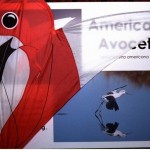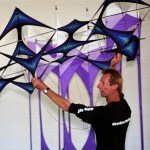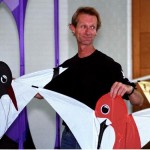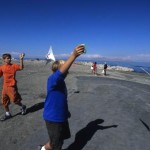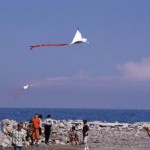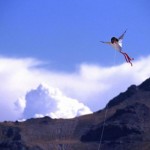In October 2004, the famed Australian kite maker Robert Brasington visited Utah for the first time. Even though he had never seen the Great Salt Lake before, Brasington already knew a lot about some of its inhabitants and visitors—the birds. As part of a commission by Brolly Arts, funded in part by the Drachen Foundation, Brasington designed a set of kites for Utah schoolchildren based on nine species of Great Salt Lake birds. He also created a set of flat, minimalist kites for a multi-media arts event in Salt Lake City.
Brasington, who lives in Tasmania, came to the project with experience building bird-inspired kites. As he told hundreds of Salt Lake City elementary schoolchildren, he watched birds flying in his yard at home, and built a few kites based on their distinctive features. When he received the assignment from Brolly Arts, he learned about the nine types of birds and their habitat, and then designed a kite for each species.
In preparation for Brasington’s visit, Bruce Thompson, director of education for Friends of the Great Salt Lake, and ornithologist Rob Wilson presented students with information about the habitats, feeding habits and migration paths of these birds. When Brasington arrived at the schools, he displayed one of the types of kites that has made him famous worldwide—a large, purple cellular kite based on the architecture of European cathedrals. The kids were hooked. Then he explained each bird kite in relation to its species (the small, squat Snowy Plover became a quick favorite) and that each student would have the chance to build his or her own version for flying at the Great Salt Lake.
“The project gave students a sense of the uniqueness and importance of a valuable ecosystem, and then lets them artistically reproduce some of its inhabitants,” says Amy Sanyer, director of Brolly Arts, the local non-profit “umbrella” arts organization that created this unique educational opportunity.
The kids decorated the pre-cut sturdy plastic-coated paper kites and learned how to attach wooden stays, string and paper tails. On a sunny day in October, school busses and parents drove the students to the shores of the Great Salt Lake. As soon as the kids got out into the open air, the bird kites started to take flight.
On the flat, sandy beach, Brasington demonstrated that his cellular kite was made to fly, despite lagging wind speeds. The children flew their newly created bird kites and quickly discovered how to release line to keep the kites air born and prevent quick nosedives.
Brasington’s visit corresponded with Brolly Arts’ multi-media arts performance, Contours, which brought together other local, national, and international artists to interpret the same birds of the Great Salt Lake. For three nights in downtown Salt Lake City, storytellers, musicians, photographers, dancers and artists worked together to remind the audience of the unique importance of the fragile ecosystem of the Great Salt Lake. By participating, Brasington added his own artistic medium to the mix, and was able to teach awareness about the natural world and kite making to the next generation.
While Brasington is most famous for his three-dimensional kites, he’s also known for his smaller, flat, minimalist kites. Brolly Arts commissioned the kite maker to create an exhibit of these types of kites for the lobby of the Jeanne Wagner Theater, where Contours took place.
In the two-story lobby that features a nearly solid wall of south-facing glass windows, Brasington set to work hanging a series of white kites from the ceiling. Many Contours attendees commented on how individually, the kites looked like ghosts, angels or Georgia O’Keefe’s cow skulls. But when placed together, the kites looked like an abstract depiction of the feathers, or contours, of a large bird wing.
The Utah-based non-profit Brolly Arts looks forward to incorporating kite making into future events, and Director Amy McDonald Sanyer, has already started exploring bringing other international kite designers to Utah for more rewarding educational and artistic projects.
Lucy Burningham
For more information about these programs,
visit the Brolly Arts web site:
To buy any of the Contours kites, contact
Robert Brasingtonthrough his web site:
http://www.webcom.com/~mrkites/groundzerokites


